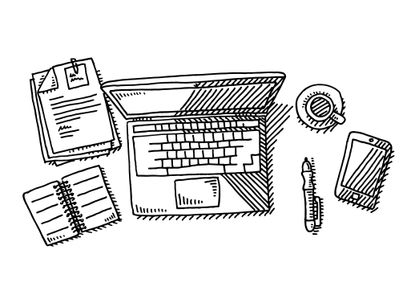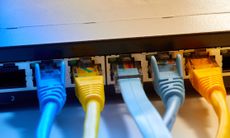How to choose and find a broadband provider
If you're struggling to find a broadband provider in your area, struggle no more — this guide has you covered.

With so many different broadband providers to choose from, working out which is the best one for you isn’t always easy.
In this guide, we explain how to find a good broadband provider for you and what to watch out for when deciding which one to go for.
How to find a broadband provider that's right for you
Not all broadband providers cater for every area of the country, so you’ll need to find a provider that not only offers the type of deal you want in terms of data and speed but which is also available where you live.
The good news is that comparison sites usually enable you to check for the specific deals you can access in your area. You’ll be asked to enter your postcode and you’ll then be shown a list of the best deals in your area. You can then filter these deals down by selecting the type of package you want, the contract length, and the monthly price you want to pay, and apply online for the deal you want.
Who has the best coverage in my location?
The provider that offers the best coverage in your location will depend on where you live, but you’ll often have a wider choice of options if you live in a town or city than if you live somewhere remote.
When you search for broadband deals using a comparison website, they will exclude providers which don’t offer coverage in your area, so you can select from the best providers which do.
Who has the best broadband speed in my area?
If you want to find out which broadband providers offer the best broadband speed in your area, your best bet is to use an online speed checker tool. For example, the Broadband Speed Checker site allows you to enter your postcode and then shows the providers offering the fastest speeds where you live.
Look After My Bills Newsletter
Get the best money-saving tips, tricks and deals sent straight to your inbox every week. Make sense of your money in partnership with The Money Edit.
What broadband speed do I need?
The fastest fast fibre connections allow you to download as much as 76 Megabits per second (Mbps) of data, which means you’ll be able to download a film in as little as around one and a half minutes. Standard speeds tend to range from around 5Mbps to 16Mbps. To put this into context, if you wanted to download a film at a speed of 16Mbps, this would take you about seven minutes.
The broadband speed you’ll need depends on how you tend to use the internet. If, for example, you only use the internet to send the odd email, or to do a bit of online shopping here and there, you’ll probably be fine with a lower speed of up to 16Mbps. If however, you rely on the internet to work and regularly need to download or send large amounts of data, you’ll need a much faster connection and may prefer to go for a fibre broadband deal.
What’s fibre broadband and can I get it?
Fibre broadband is the fastest type of internet connection you can get. As the name suggests, fibre optic cables are used to transmit broadband straight into your home. Data can travel much more quickly via these cables than copper wires, so download speeds are usually exceptionally fast. Whether you can get fibre broadband depends on where you live as it isn’t yet available in some rural locations.
If you want to see which broadband services are available in your area and whether you have access to fibre where you live, again you can use Ofcom’s Broadband and mobile coverage checker.
Do you need a phone line for fibre broadband?
As fibre broadband is supplied via cables, you can get internet access without having a landline. That means if you rely on your mobile to make calls, and don’t have a home phone, you can still access fibre broadband as long as it is available in your area.
However, not all homes yet have access to fibre and in some cases receive broadband via what’s known as Fibre to the Cabinet (FTTC). This means you’re connected by fibre optic cable to your nearest telephone exchange and then via copper wires to your home. In this case, you would still need a phone line to get fibre broadband.
Internet connection options
There are two main ways to connect to the internet. The first is using what’s known as an Asymmetric Digital Subscriber Line (ADSL), which means your internet connection is provided through your home telephone line.
The other way is through a fibre connection which means your data is transmitted via fibre optic cables. Speeds are usually much faster than those available from ADSL connections, but fibre optic isn’t available in all areas. If you don’t have a fibre connection to your home, often fibre can be provided to the local telephone exchange and then via wires to your home, which still makes it much faster than a standard ADSL connection.
What else should I look out for?
When choosing a broadband provider, it’s vital to look really carefully at whether you’re getting the speed and data limits you need, and exactly how much it will cost, including any installation or set-up charges.
You should also consider the length of the contract you’re signing up for, as there will usually be early access penalties if you want to leave your deal early for any reason.
It can be a good idea to check in with your neighbours too, to find out which providers they use and whether they are happy with the speeds and service they receive.
Related articles
-
 Three energy firms pay £8m in switching compensation - has your provider paid out?
Three energy firms pay £8m in switching compensation - has your provider paid out?More than 100,000 customers have received compensation after changing providers, but is now a good time to switch energy suppliers?
By Tom Higgins Published
-
 Save £300 on your supermarket shop with cashback accounts
Save £300 on your supermarket shop with cashback accountsBanks, credit card companies and cashback sites are all offering cashback on your supermarket shop, but can you use them all to max out your savings?
By Vaishali Varu Published
-
 Three energy firms pay £8m in switching compensation - has your provider paid out?
Three energy firms pay £8m in switching compensation - has your provider paid out?More than 100,000 customers have received compensation after changing providers, but is now a good time to switch energy suppliers?
By Tom Higgins Published
-
 HMRC tax credit renewal packs: act quickly to avoid losing benefit payments
HMRC tax credit renewal packs: act quickly to avoid losing benefit paymentsHouseholds receiving tax credits will be asked to confirm their details to ensure they continue to receive their entitlement. Here’s everything you need to know to make sure you don’t miss out on up to £3,480 a year
By Tom Higgins Published
-
 Mobile provider rewards: how to earn up to £700
Mobile provider rewards: how to earn up to £700Your phone could be the key to unlocking hundreds of pounds worth of discounts and freebies that you don’t even know about. We reveal which mobile providers offer the best rewards
By Vaishali Varu Published
-
 How much do cooking appliances cost to run?
How much do cooking appliances cost to run?Energy-saving cooking tips from the Energy Saving Trust
By Katie Binns Published
-
 Virgin Media leaves thousands without broadband: are customers entitled to compensation?
Virgin Media leaves thousands without broadband: are customers entitled to compensation?Tens of thousands of Virgin Media customers were hit by broadband outages yesterday. We explain your rights if your broadband goes down
By Katie Binns Published
-
 Broadband switching service delayed - how it will eventually work and why it’s crucial to switch
Broadband switching service delayed - how it will eventually work and why it’s crucial to switchA broadband switching service designed to make it easier to change to a cheaper or faster deal has been delayed. We explain how you can still avoid huge increases to your monthly internet bill
By Katie Binns Published
-
 Heat pumps: why you can claim a £5,000 government grant for longer
Heat pumps: why you can claim a £5,000 government grant for longerWhy you now have more time to apply for a government grant towards getting a heat pump in your home
By Sue Hayward Published
-
 British Gas cuts energy bills by £15 for prepayment meter customers from April
British Gas cuts energy bills by £15 for prepayment meter customers from AprilOne million British Gas customers on energy prepayment meters will save around £15 as British Gas cuts its penalty three months early
By Sue Hayward Published